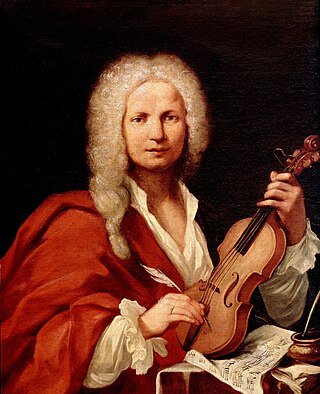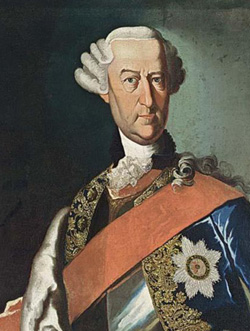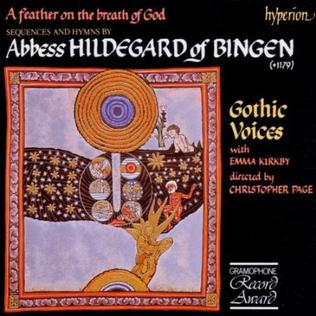
Hildegard of Bingen, also known as Saint Hildegard and the Sibyl of the Rhine, was a German Benedictine abbess and polymath active as a writer, composer, philosopher, mystic, visionary, and as a medical writer and practitioner during the High Middle Ages. She is one of the best-known composers of sacred monophony, as well as the most recorded in modern history. She has been considered by scholars to be the founder of scientific natural history in Germany.
The da capo aria is a musical form for arias that was prevalent in the Baroque era. It is sung by a soloist with the accompaniment of instruments, often a small orchestra. The da capo aria is very common in the musical genres of opera and oratorio. According to Randel, a number of Baroque composers composed more than a thousand da capo arias during their careers.
Walter Frye was an English composer of the early Renaissance.

A salpinx was a trumpet-like instrument of the ancient Greeks.

The Croix Sonore is an early electronic musical instrument with continuous pitch, similar to the theremin. Like the theremin, the pitch of the tone is dependent on the nearness of the player's arm to an antenna; unlike the theremin, the antenna was in the shape of a cross, and the electronics were inside a brass ball to which the cross was affixed.
Sulpitia Lodovica Cesis was born on 15 May 1577 in Modena, Italy. She was an Italian composer as well as a well-regarded lutenist. Her father was Count Annibale Cesis and he gave 300 pieces of gold for her dowry when she entered the Augustinian convent in Modena in 1593. She was a nun at the convent of Saint Geminiano in Modena, although some sources report it as Saint Agostino. Her only known work is a volume of Motetti Spirituali, which she wrote in 1619.

Tito Manlio is an opera in three acts by Antonio Vivaldi, to a libretto by Matteo Noris. It was written in celebration of the marriage of Philip of Hesse-Darmstadt (1671–1736), the governor of Mantua, which he had announced at Christmas. Vivaldi quickly composed the opera within five days. Whereas the wedding eventually did not take place at all, the opera was successfully premiered at the Teatro Arciducale ‘detto il Comico’ in Mantua during the carnival season of 1719.
Nancy Dalberg was a Danish composer.
Nikolai Vladimirovich Shcherbachov was a Russian composer and pianist.
Luis Misón was a Spanish composer. Born in Mataró, Barcelona, he composed over 100 tonadillas, including Una mesonera y un arriero, which contains the song "Seguidilla dolorosa de una enamorada" ("Painful song of a girl in love", Los ciegos, and El maestro de baile.

This is a discography of Hildegard of Bingen's musical works.

Gesang der Parzen, Op. 89, is a piece for mixed choir and orchestra by Johannes Brahms.

Philip of Hesse-Darmstadt was a Prince of Hesse-Darmstadt, Imperial Field marshal and Governor of Mantua.
Friedhelm Döhl was a German composer and professor of music.
Conradus de Pistoria was an Italian composer of the late medieval era and early Renaissance, active in Florence and elsewhere in northern Italy. He is listed in the standard histories of music for the period, including the New Oxford History of Music: Ars Nova and the Renaissance, 1300–1540, and the New Grove. Conradus was an Italian representative of the manneristic school of composers known as the ars subtilior, closely associated with the courts of the schismatic popes during the period of the Avignon Papacy.
Matheus de Sancto Johanne, also known as Mayshuet, was a French composer of the late Medieval era. Active both in France and England, he was one of the representatives of the complex, manneristic musical style known as the ars subtilior which flourished around the court of the Avignon Papacy during the Great Schism.
Tomasz Szadek was a Polish composer, singer, and cleric of the late Renaissance. He was a representative of the late style of the Franco-Flemish school in Poland.
The Divertimento in G major, Hob. XVI/8, L. 1, was written in 1766 by Joseph Haydn.

A Feather on the Breath of God is an album of sacred vocal music written in the 12th century by the German abbess Hildegard of Bingen, and recorded by British vocal ensemble Gothic Voices with English soprano Emma Kirkby. It was released by the Hyperion Records label in 1982.
"Let Evening Come" is a poem by Jane Kenyon.







